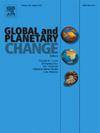Last-stage southward subduction of the central segment of the Paleo-Asian Ocean: Insights from Middle-Late Permian granites in the Siziwangqi area in Inner Mongolia, China
IF 4
1区 地球科学
Q1 GEOGRAPHY, PHYSICAL
引用次数: 0
Abstract
Arc magmatism in collisional orogens presents persistent challenges in discriminating terminal subduction signatures due to potential overlap with slab underthrusting processes during continental convergence. This ambiguity is particularly pronounced in multi-arc accretionary systems such as the Central Asian Orogenic Belt (CAOB), where the cessation timing of Paleo-Asian Ocean (PAO) southward subduction remains contentious. We address this debate through integrated geochronological and geochemical investigations of Middle-Late Permian granitoids (252–260 Ma) from the Bainaimiao Arc Belt, a critical component of the North China Collage System. Zircon U![]() Pb data resolve two distinct magmatic phases: (1) 258–260 Ma calc-alkaline granites exhibiting arc-like signatures (enriched LILEs, depleted HFSEs), and (2) 252–254 Ma highly fractionated alkaline granites with elevated SiO2 (∼66.49–77.71 wt%), total alkalis (Na2O + K2O = ∼6.88–9.55), and diagnostic trace element ratios (Nb/Ta = ∼4.4–16.8; Zr/Hf = ∼13.5–39.2). Our findings redefine the tectonic evolution of the western Bainaimiao Arc: Andean-style continental arc magmatism persisted through the Carboniferous-Early Permian (>280 Ma), transitioning to hybrid arc/crustal sources with addition of the CAOB juvenile crusts during 260–280 Ma, as evidenced by increased zircon εHf(t) (∼ − 18 to 12), and whole-rock εNd(t) (∼ − 13 to −4) values with elevated SiO2 (most >70.00 wt%). These 260–280 Ma arc-resembling magmas, coeval with regional A-type granites and bimodal volcanism, constrain terminal PAO subduction to ∼260 Ma. Such arc-resembling magmatism has been well documented in other orogens worldwide, suggesting oceanic slab consumption during collisions as a global phenomenon. In addition, we highlight that subduction-driven magmatism is an important supplement to crustal anatexis during collisions.
Pb data resolve two distinct magmatic phases: (1) 258–260 Ma calc-alkaline granites exhibiting arc-like signatures (enriched LILEs, depleted HFSEs), and (2) 252–254 Ma highly fractionated alkaline granites with elevated SiO2 (∼66.49–77.71 wt%), total alkalis (Na2O + K2O = ∼6.88–9.55), and diagnostic trace element ratios (Nb/Ta = ∼4.4–16.8; Zr/Hf = ∼13.5–39.2). Our findings redefine the tectonic evolution of the western Bainaimiao Arc: Andean-style continental arc magmatism persisted through the Carboniferous-Early Permian (>280 Ma), transitioning to hybrid arc/crustal sources with addition of the CAOB juvenile crusts during 260–280 Ma, as evidenced by increased zircon εHf(t) (∼ − 18 to 12), and whole-rock εNd(t) (∼ − 13 to −4) values with elevated SiO2 (most >70.00 wt%). These 260–280 Ma arc-resembling magmas, coeval with regional A-type granites and bimodal volcanism, constrain terminal PAO subduction to ∼260 Ma. Such arc-resembling magmatism has been well documented in other orogens worldwide, suggesting oceanic slab consumption during collisions as a global phenomenon. In addition, we highlight that subduction-driven magmatism is an important supplement to crustal anatexis during collisions.
古亚洲洋中段最后阶段向南俯冲:内蒙古四子王旗地区中晚二叠世花岗岩的启示
碰撞造山带的弧岩浆活动由于在大陆辐合过程中可能与板块逆冲下推过程重叠,给鉴别最终俯冲特征带来了持续的挑战。这种模糊性在中亚造山带(CAOB)等多弧增生系统中尤为明显,古亚洲洋(PAO)向南俯冲的停止时间仍然存在争议。本文通过对华北拼合体系重要组成部分白乃庙弧带中-晚二叠世花岗岩类(252-260 Ma)的年代学和地球化学综合研究来解决这一争论。锆石UPb数据解析了两个不同的岩浆阶段:(1)258-260 Ma钙碱性花岗岩,表现出弧状特征(富集LILEs,贫HFSEs); (2) 252-254 Ma高分选碱性花岗岩,其SiO2 (~ 66.49-77.71 wt%)、总碱(Na2O + K2O = ~ 6.88-9.55)和诊断微量元素比率(Nb/Ta = ~ 4.4-16.8;Zr/Hf = ~ 13.5-39.2)。研究结果重新定义了白奈庙弧西部的构造演化:在石炭纪-早二叠世(>280 Ma),安第斯式大陆弧岩浆活动持续存在,在260-280 Ma期间,随着CAOB幼年地壳的加入,向弧-地壳混合源过渡,锆石εHf(t)(~−18 ~ 12)升高,全岩εNd(t)(~−13 ~−4)值升高,SiO2(大部分>;70.00 wt%)升高。这些260 - 280 Ma的弧状岩浆,与区域a型花岗岩和双峰火山作用同期,限制了PAO末期俯冲至~ 260 Ma。这种类似弧形的岩浆活动在世界各地的其他造山带中都有很好的记录,这表明碰撞过程中海洋板块的消耗是一种全球现象。此外,我们强调俯冲驱动的岩浆作用是碰撞过程中地壳深熔作用的重要补充。
本文章由计算机程序翻译,如有差异,请以英文原文为准。
求助全文
约1分钟内获得全文
求助全文
来源期刊

Global and Planetary Change
地学天文-地球科学综合
CiteScore
7.40
自引率
10.30%
发文量
226
审稿时长
63 days
期刊介绍:
The objective of the journal Global and Planetary Change is to provide a multi-disciplinary overview of the processes taking place in the Earth System and involved in planetary change over time. The journal focuses on records of the past and current state of the earth system, and future scenarios , and their link to global environmental change. Regional or process-oriented studies are welcome if they discuss global implications. Topics include, but are not limited to, changes in the dynamics and composition of the atmosphere, oceans and cryosphere, as well as climate change, sea level variation, observations/modelling of Earth processes from deep to (near-)surface and their coupling, global ecology, biogeography and the resilience/thresholds in ecosystems.
Key criteria for the consideration of manuscripts are (a) the relevance for the global scientific community and/or (b) the wider implications for global scale problems, preferably combined with (c) having a significance beyond a single discipline. A clear focus on key processes associated with planetary scale change is strongly encouraged.
Manuscripts can be submitted as either research contributions or as a review article. Every effort should be made towards the presentation of research outcomes in an understandable way for a broad readership.
 求助内容:
求助内容: 应助结果提醒方式:
应助结果提醒方式:


